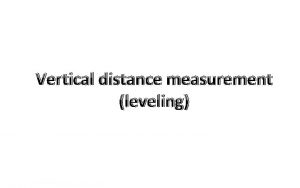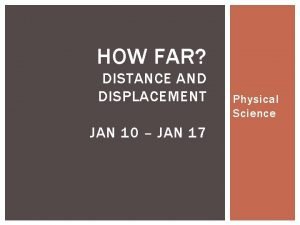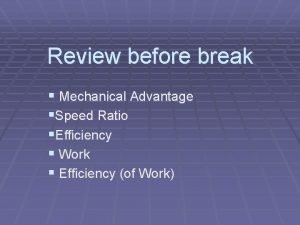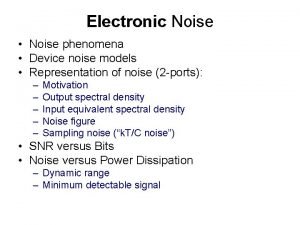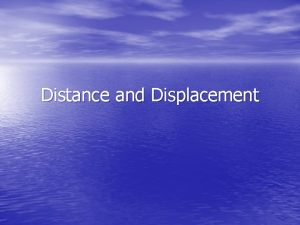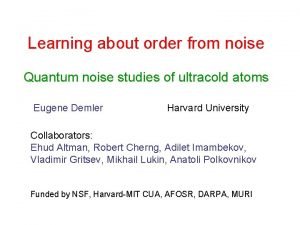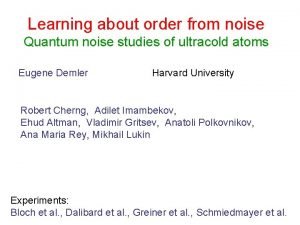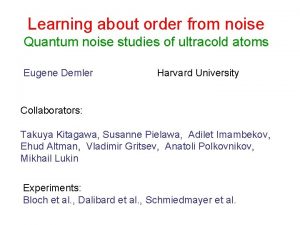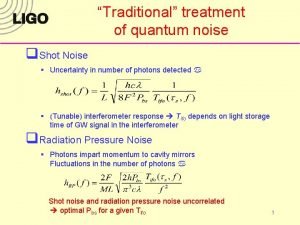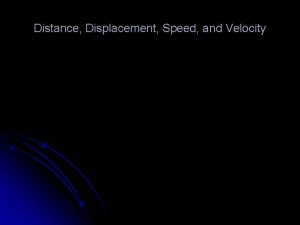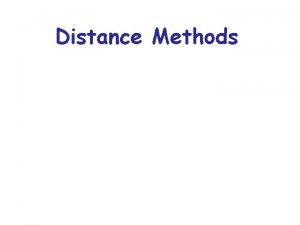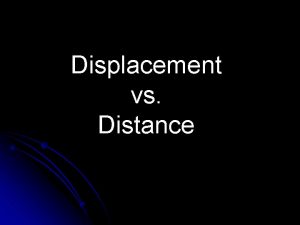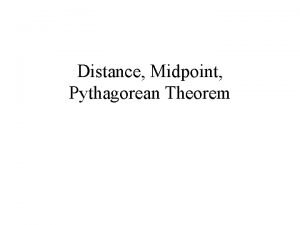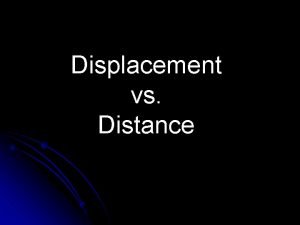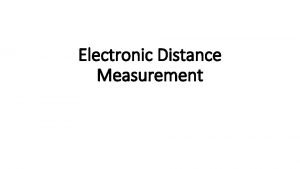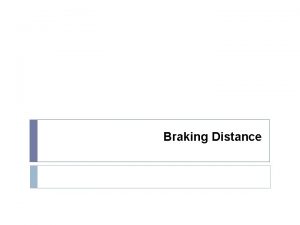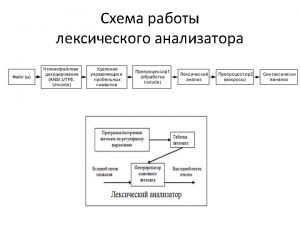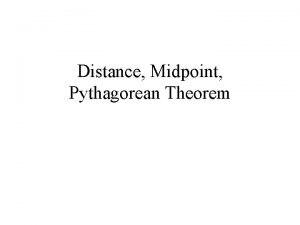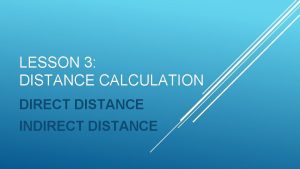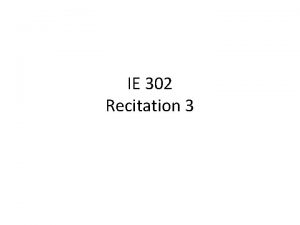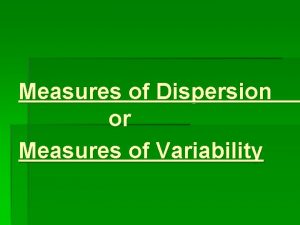More Quantum Noise and Distance Measures for Quantum




























- Slides: 28

More Quantum Noise and Distance Measures for Quantum Information (Some of Ch 8 and Ch 9) Patrick Cassleman EECS 598 11/29/01 Advanced Computer Architecture Lab University of Michigan Quantum Noise and Distance Patrick Cassleman

Outline • Types of Quantum Noise – – – Bit Flip Phase Flip Bit-phase Flip Depolarizing Channel Amplitude Damping Phase Damping • Distance measures for Probability Distributions • Distance measures for Quantum States Advanced Computer Architecture Lab University of Michigan Quantum Noise and Distance Patrick Cassleman

Background – The Bloch Sphere • Remember : • The numbers q and j define a point on the unit three-dimensional sphere q Advanced Computer Architecture Lab University of Michigan Quantum Noise and Distance Patrick Cassleman

Examples of Quantum Noise – Bit Flip • A bit flip channel flips the state of a qubit from |1> with probability 1 -p • Operation Elements: Advanced Computer Architecture Lab University of Michigan |0> to Quantum Noise and Distance Patrick Cassleman

Examples of Quantum Noise – Bit Flip • Bloch sphere representation: – Before y -After z x Advanced Computer Architecture Lab University of Michigan Quantum Noise and Distance Patrick Cassleman

Examples of Quantum Noise - Phase Flip • Corresponds to a measurement in the |0>, |1> basis, with the result of the measurement unknown • Operation Elements: Advanced Computer Architecture Lab University of Michigan Quantum Noise and Distance Patrick Cassleman

Examples of Quantun Noise – Phase Flip • Bloch vector is projected along the z axis, and the x and y components of the Bloch vector are lost Advanced Computer Architecture Lab University of Michigan Quantum Noise and Distance Patrick Cassleman

Examples of Quantum Noise – Bitphase Flip • A combination of bit flip and phase flip • Operation Elements: Advanced Computer Architecture Lab University of Michigan Quantum Noise and Distance Patrick Cassleman

Examples of Quantum Noise – Bitphase Flip • Bloch vector is projected along y-axis, x and z components of the Bloch vector are lost Advanced Computer Architecture Lab University of Michigan Quantum Noise and Distance Patrick Cassleman

Examples of Quantum Noise – Depolarizing Channel • Qubit is replaced with a completely mixed state I/2 with probability p, it is left untouched with probability 1 -p • The state of the quantum system after the noise is: Advanced Computer Architecture Lab University of Michigan Quantum Noise and Distance Patrick Cassleman

Examples of Quantum Noise – Depolarizing Channel • The Bloch sphere contracts uniformly Advanced Computer Architecture Lab University of Michigan Quantum Noise and Distance Patrick Cassleman

Examples of Quantum Noise – Depolarizing Channel • Quantum Circuit Representation r I/2 (1 -p)|0><0|+p|1><1| Advanced Computer Architecture Lab University of Michigan Quantum Noise and Distance Patrick Cassleman

Examples of Quantum Noise – Amplitude Damping • Noise introduced by energy dissipation from the quantum system – Emitting a photon • The quantum operation: Advanced Computer Architecture Lab University of Michigan Quantum Noise and Distance Patrick Cassleman

Examples of Quantum Noise – Amplitude Damping • Operation Elements: • can be thought of as the probability of losing a photon • E 1 changes |1> into |0> - i. e. losing energy • E 0 leaves |0> alone, but changes amplitude of |1> Advanced Computer Architecture Lab University of Michigan Quantum Noise and Distance Patrick Cassleman

Examples of Quantum Noise – Amplitude Damping • Quantum Circuit Representation: Advanced Computer Architecture Lab University of Michigan Quantum Noise and Distance Patrick Cassleman

Examples of Quantum Noise – Amplitude Damping • Bloch sphere Representation: • The entire sphere shrinks toward the north pole, |0> Advanced Computer Architecture Lab University of Michigan Quantum Noise and Distance Patrick Cassleman

Examples of Quantum Noise – Phase Damping • Describes the loss of quantum information without the loss of energy • Electronic states perturbed by interacting with different charges • Relative phase between energy eigenstates is lost • Random “phase kick”, which causes non diagonal elements to exponentially decay to 0 • Operation elements: • l = probability that photon scattered without losing Quantum Noise and Distance Patrick Cassleman energy Advanced Computer Architecture Lab University of Michigan

Examples of Quantum Noise – Phase Damping • Quantum Circuit Representation: • Just like Amplitude Damping without the CNOT gate Advanced Computer Architecture Lab University of Michigan Quantum Noise and Distance Patrick Cassleman

Box 8. 4 – Why Shrodinger’s Cat Doesn’t Work • How come we don’t see superpositions in the world we observe? • The book blames: the extreme sensitivity of macroscopic superposition to decoherence • i. e it is impossible in practice to isolate the cat and the atom in their box – Unintentional measurements are made • Heat leaks from the box • The cat bumps into the wall • The cat meows • Phase damping rapidly decoheres the state into either alive or dead Advanced Computer Architecture Lab University of Michigan Quantum Noise and Distance Patrick Cassleman

Distance measures for Probability Distributions • We need to compare the similarity of two probability distributions • Two measures are widely used: trace distance and fidelity • Trace distance also called L 1 distance or Kalmogorov distance • Trace Distance of two probability distributions px and qx: • The probability of an error in a channel is equal to the Advanced Computer Architecture Lab Quantum Noise and Distance University of Michigan Patrickit. Cassleman trace distance of the probability distribution before enters the channel and the probability distribution

Distance measures for Probability Distributions • Fidelity of two probability distributions: • Fidelity is not a metric, when the distributions are equal, the fidelity is 1 • Fidelity does not have a clear interpretation in the real world Advanced Computer Architecture Lab University of Michigan Quantum Noise and Distance Patrick Cassleman

Distance measures for Quantum States • How close are two quantum states? • The trace distance of two quantum states r and s: • If r and s commute, then the quantum trace distance between r and s is equal to the classical trace distance between their eigenvalues • The trace distance between two single qubit states is half the ordinary Euclidian distance between them on the Bloch sphere Advanced Computer Architecture Lab University of Michigan Quantum Noise and Distance Patrick Cassleman

Trace Preserving Quantum Operations are Contractive • Suppose E is a trace preserving quantum operation. Let r and s be density operators. Then • No physical process ever increases the distance between two quantum states Advanced Computer Architecture Lab University of Michigan Quantum Noise and Distance Patrick Cassleman

Fidelity of Two Quantum States • When r and s commute (diagonal in the same basis), degenerates into the classical fidelity, F(ri, si) of their eigenvalue distributions • The fidelity of a pure state and an arbitrary state r: • That is, the square root of the overlap Advanced Computer Architecture Lab University of Michigan Quantum Noise and Distance Patrick Cassleman

Uhlmann’s Theorem • Given r and s are states of a quantum system Q, introduce a second quantum system R which is a copy of Q Then: • Where the maximizaion is over all purifications |y> of r and |j> of s into RQ • Proof in the book Advanced Computer Architecture Lab University of Michigan Quantum Noise and Distance Patrick Cassleman

Turning Fidelity into a Metric • The angle between states r and s is: • The triangle inequality: • Fidelity is like an upside down version of trace distance – Decreases as states become more distinguishable – Increases as states become less distinguishable – Instead of contractivity, we have monotonicity Advanced Computer Architecture Lab University of Michigan Quantum Noise and Distance Patrick Cassleman

Monotonicity of Fidelity • Suppose E is a trace preserving quantum operation, let r and s be density operators, then: • Trace distance and Fidelity are qualitatively equivalent measures of closeness for quantum states – Results about one may be used to deduce equivalent results about the other – Example: Advanced Computer Architecture Lab University of Michigan Quantum Noise and Distance Patrick Cassleman

Conclusions • Quantum Noise is modeled as an operator on a state and the environment • Quantum Noise can be seen as a manipulation of the Bloch sphere • Fidelity and Trace distance measure the relative distance between two quantum states • Quantum noise and distance will be important in the understanding of quantum error correction next week Advanced Computer Architecture Lab University of Michigan Quantum Noise and Distance Patrick Cassleman
 Lirik lagu more more more we praise you
Lirik lagu more more more we praise you More more more i want more more more more we praise you
More more more i want more more more more we praise you Pcm companding
Pcm companding Air pollution consequences
Air pollution consequences Anova repeated measures
Anova repeated measures Measurement of vertical distances
Measurement of vertical distances How is distance different from displacement
How is distance different from displacement Quantum physics vs quantum mechanics
Quantum physics vs quantum mechanics Quantum physics vs mechanics
Quantum physics vs mechanics Human history becomes more and more a race
Human history becomes more and more a race The ratio of input distance to output distance
The ratio of input distance to output distance The more you take the more you leave behind
The more you take the more you leave behind The more you study the more you learn
The more you study the more you learn Aspire not to
Aspire not to Examples of newtons first law
Examples of newtons first law Knowing more remembering more
Knowing more remembering more More love to thee o lord
More love to thee o lord More choices more chances
More choices more chances Iso 22301 utbildning
Iso 22301 utbildning Typiska drag för en novell
Typiska drag för en novell Nationell inriktning för artificiell intelligens
Nationell inriktning för artificiell intelligens Returpilarna
Returpilarna Varför kallas perioden 1918-1939 för mellankrigstiden
Varför kallas perioden 1918-1939 för mellankrigstiden En lathund för arbete med kontinuitetshantering
En lathund för arbete med kontinuitetshantering Personalliggare bygg undantag
Personalliggare bygg undantag Tidböcker
Tidböcker Sura för anatom
Sura för anatom Vad är densitet
Vad är densitet Datorkunskap för nybörjare
Datorkunskap för nybörjare





